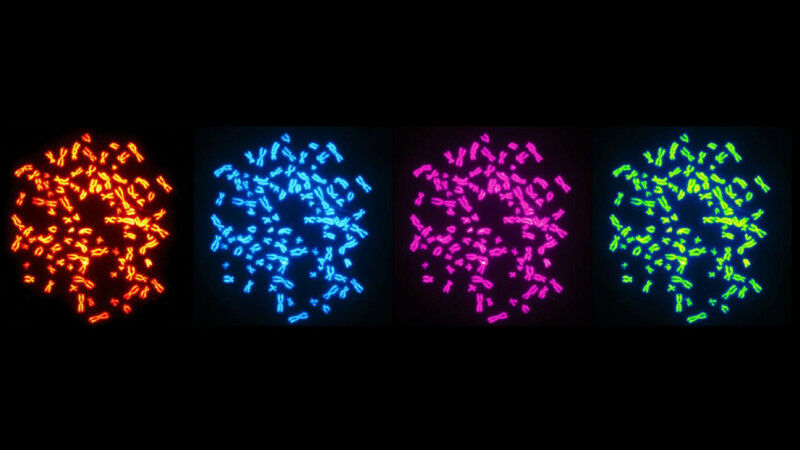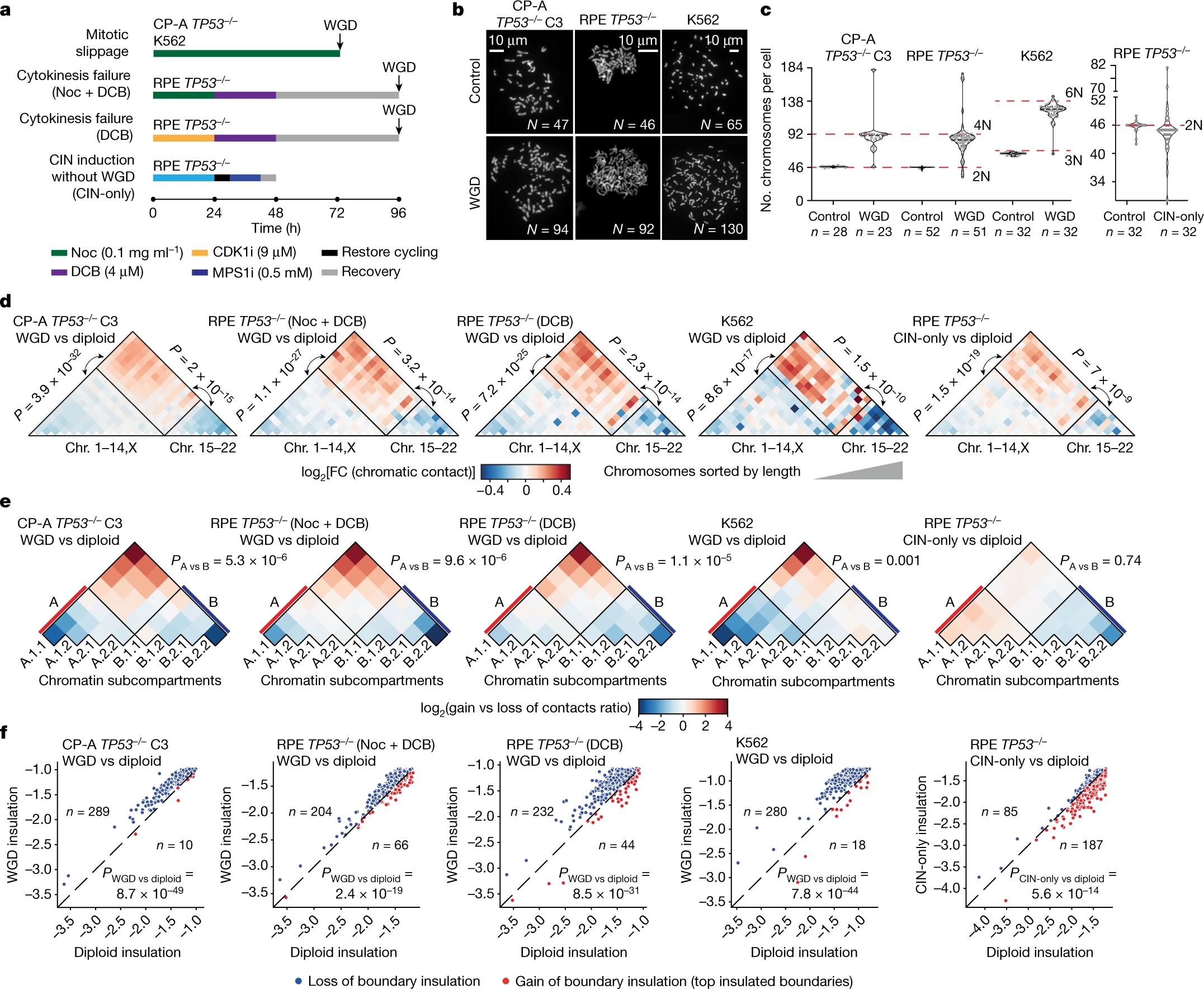《自然》:基因组加倍如何帮助癌症发展
诸平

Fig. 2: WGD induces LCS
据瑞士洛桑联邦理工学院(Swiss Federal Institute of Technology Lausanne简称EPFL)2023年3月28日提供的消息,瑞士多家机构的研究人员合作,揭示了全基因组加倍促进机体癌症发生的分子机制(How genome doubling helps cancer develop)。上述图片显示了全基因组加倍的细胞中的染色体。相关研究结果于2023年3月15日已经在《自然》(Nature)杂志网站发表——Ruxandra A. Lambuta, Luca Nanni, Yuanlong Liu, Juan Diaz-Miyar, Arvind Iyer, Daniele Tavernari, Natalya Katanayeva, Giovanni Ciriello, Elisa Oricchio. Whole genome doubling drives oncogenic loss of chromatin segregation. Nature, Published: 15 March 2023. DOI: 10.1038/s41586-023-05794-2. https://www.nature.com/articles/s41586-023-05794-2
参与此项研究有来自瑞士洛桑联邦理工学院(EPFL, écublens, Switzerland)、瑞士洛桑莱曼瑞士癌症中心(Swiss Cancer Center Leman, Lausanne, Switzerland)、瑞士洛桑大学{University of Lausanne (UNIL), Lausanne, Switzerland}以及瑞士洛桑生物信息研究所{ Swiss Institute of Bioinformatics (SIB), Lausanne, Switzerland}的研究人员。
EPFL和UNIL的研究人员发现了癌症发展的新方式:全基因组加倍 (whole genome doubling简称WGD)改变了DNA在3D空间中的组织方式,从而激活了驱动癌症生长的致癌基因(oncogenes)。
单个细胞包含2-3米长的DNA,这意味着储存它的唯一方法是将其包裹成紧密的线圈。解决方案是染色质(chromatin):一种包裹在称为组蛋白(histones)的蛋白质周围的DNA复合物。在3D空间中,这个复合体逐渐折叠成一个由环(loops)、结构域(domains)和区室(compartments)组成的多层组织,这构成了我们所知的染色体。染色质的组织与基因表达和细胞的正常功能密切相关,因此染色质结构的任何问题都可能产生不利影响,包括癌症的发展。
大约30%的人类癌症中的一个常见事件是“全基因组加倍”(WGD),即细胞中的整组染色体被复制。WGD导致细胞内的基因组不稳定,这可能导致染色体改变和其他有助于癌症发展的突变。
现在,由EPFL的埃莉萨·奥里奇奥(Elisa Oricchio)和洛桑大学(UNIL)的乔瓦尼·奇列洛(Giovanni Ciriello)领导的一组研究人员发现了关于WGD如何导致癌症的新线索。在《自然》(Nature)杂志上发表的上述研究论文中,科学家们表明,WGD可以通过一种称为“染色质分离缺失”(“loss of chromatin segregation”简称LCS)的现象影响细胞内染色质的3D组织。
研究人员观察了缺乏肿瘤抑制基因p53(tumor suppressor gene p53)的细胞,使它们容易发生WGD。他们发现WGD导致染色质结构元素(如环、结构域和区室)的分离减少,从而颠覆了其在细胞中的精心组织。
结果是混合了通常保持独立的遗传物质,改变了基因组区域在3D空间中的位置,称为“子区室重新定位(sub-compartment repositioning)”。这为致癌基因的激活奠定了基础,致癌基因是导致癌症发展的基因。
研究人员还发现,WGD对染色质组织的影响在很大程度上与染色体改变无关,这意味着染色质分离(chromatin segregation)的丧失和染色体不稳定是共同促进癌症发展的互补机制。
这项工作提供了一种新的方式来研究WGD和染色质组织在癌症发展中的作用。在未来,高度多重化的单细胞分子图谱,结合条形码技术(barcoding technologies)和新的计算方法,可能有助于进一步揭示染色质3D结构的解体在将细胞转化为癌变细胞中所起的作用。
本研究得到了EPFL、UNIL、瑞士国家科学基金会(Swiss National Science Foundation简称SNSF)以及瑞士癌症联盟(Swiss Cancer League)的支持或资助。
上述介绍,仅供参考。欲了解更多信息,敬请注意浏览原文或者相关报道。
https://news.bioon.com/article/6849e6362557.html
Whole-genome doubling (WGD) is a recurrent event in human cancers and it promotes chromosomal instability and acquisition of aneuploidies1,2,3,4,5,6,7,8. However, the three-dimensional organization of chromatin in WGD cells and its contribution to oncogenic phenotypes are currently unknown. Here we show that in p53-deficient cells, WGD induces loss of chromatin segregation (LCS). This event is characterized by reduced segregation between short and long chromosomes, A and B subcompartments and adjacent chromatin domains. LCS is driven by the downregulation of CTCF and H3K9me3 in cells that bypassed activation of the tetraploid checkpoint. Longitudinal analyses revealed that LCS primes genomic regions for subcompartment repositioning in WGD cells. This results in chromatin and epigenetic changes associated with oncogene activation in tumours ensuing from WGD cells. Notably, subcompartment repositioning events were largely independent of chromosomal alterations, which indicates that these were complementary mechanisms contributing to tumour development and progression. Overall, LCS initiates chromatin conformation changes that ultimately result in oncogenic epigenetic and transcriptional modifications, which suggests that chromatin evolution is a hallmark of WGD-driven cancer.
转载本文请联系原作者获取授权,同时请注明本文来自诸平科学网博客。
链接地址:https://wap.sciencenet.cn/blog-212210-1382339.html?mobile=1
收藏


